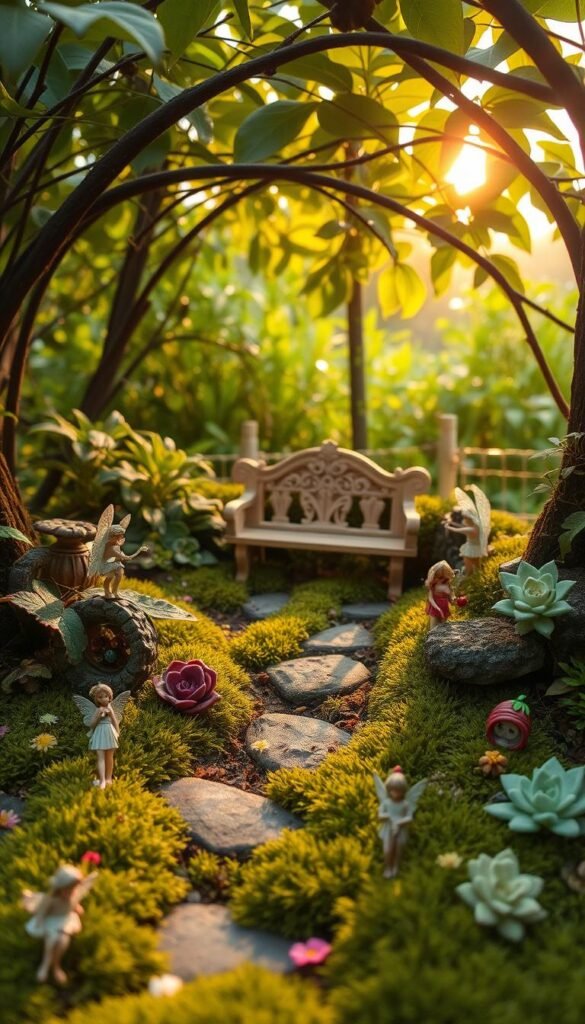Imagine crafting a tiny realm where magic feels tangible and wonder grows around every corner. Building miniature landscapes lets you blend nature’s charm with creative freedom, whether you’re a seasoned gardener or just starting your green journey.
Many enthusiasts love using living greenery but face challenges like tricky weather or time constraints. That’s where strategic combinations shine – pairing resilient plants with weatherproof accents lets your creation thrive through seasons. You maintain nature’s beauty while reducing watering and pruning tasks.
This approach opens possibilities for anyone to design captivating spaces. Arrange flowering succulents beside glittering mushroom houses, or let ivy vines frame a miniature stone path. Your setup becomes a storytelling canvas that evolves with your imagination.
Through this guide, you’ll discover how to balance organic growth with permanent decorative features. Learn which plants work best in small spaces and how to position artificial elements for natural-looking magic. Transform any nook into an interactive wonderland that delights visitors young and old alike.
Designing Your Enchanted Fairy Garden Space

Creating a miniature paradise begins with choosing themes that spark joy. Whether you dream of coastal vibes with tiny seashells or a mystical forest with toadstool cottages, your garden ideas set the stage for endless creativity. Let’s explore how to transform your vision into a cohesive design that feels alive.
Finding Inspiration and Setting the Vision
Start by observing nature or recalling favorite stories. A camping-themed setup might feature mini tents beside “rivers” of blue gravel, while a woodland scene could include bark bridges over mossy hills. Personal experiences work wonders too – like designing a birthday party activity where kids craft their own magical spaces.
Planning Your Layout and Theme
Measure your available space before selecting plants and decorations. Small tabletop gardens thrive with succulents and pebble paths, while larger outdoor areas allow for climbing vines around fairy cottages. Always leave room for growth – both for your plants and future storytelling elements like seasonal accessories.
Balance is key. Pair low-maintenance herbs with durable resin mushrooms, or let flowering groundcover frame a glittering crystal pond. Consider sunlight patterns and weather when positioning delicate faux pieces among living greenery. This ensures your creation stays vibrant through rain, shine, or curious fingers!
Choosing the Perfect Container and Base Elements

Your fairy garden’s foundation starts with picking the right home and base layers. Whether using thrifted treasures or store-bought pots, your choices shape both style and functionality. Let’s explore how to turn ordinary items into magical foundations.
Selecting Containers: Pots, Recyclables, and Unique Finds
Old teacups, cracked clay pots, or even tin cans become charming containers with personality. Drainage holes matter only for live plants – artificial setups thrive in sealed vessels. This lets you repurpose cookie tins or vintage bowls without drilling.
Establishing a Stable Base with Soil, Pebbles, and Moss
Start with a layer of pebbles for airflow. Add activated charcoal if using enclosed containers – it stops mold. Top with floral foam for faux plants or quality soil for living greenery. Finish with moss or fairy grass to hide the base.
Covering materials like marble slabs or decorative stones add texture. These elements create winding paths or “rivers” in your miniature world. Remember: proper layering prevents water damage and keeps your creation fresh for seasons.
Mixing Real Plants and Faux Accents in Your Fairy Garden Setup

The secret to a thriving miniature landscape lies in balancing organic growth with durable decorations. By combining plants that suit your local climate with imaginative faux touches, you create a space that stays vibrant through seasons.
Real Versus Artificial: Benefits and Considerations
Living succulents like echeveria thrive in arid zones, needing minimal water. But harsh weather can damage delicate flowers. That’s where artificial versions shine – they keep their color during droughts or heavy rains.
In my San Diego garden, I mix real sempervivum with faux ferns. This approach lets me enjoy natural textures while reducing upkeep. Always match your plant choices to sunlight patterns and seasonal changes.
Highlighting Faux Features: Miniatures and Storytelling
Weatherproof accessories become focal points. Place a tiny resin bench under artificial ivy, or nestle glittering mushrooms beside living sedum. These mini elements add personality without demanding care.
Rotate supplies seasonally – add pumpkin furniture in fall or snow-dusted evergreens in winter. Your creation stays fresh year-round, blending the best of nature and imagination.
Step-by-Step Guide to Assembling Your Miniature Wonderland

Building your miniature wonderland combines craftsmanship with nature’s rhythm. Follow these steps to craft a durable, eye-catching scene that balances practicality with enchantment.
Preparing Your Ground and Building the Foundation
Start by filling your container with well-draining soil. For multi-level designs, stack river rocks or broken tiles in gaps. Mix clay-heavy dirt from your yard with water to create natural mortar – this secures stones while letting roots breathe.
Layering Plants and Creating Whimsy with Supports and Pathways
Place taller plants first, like dwarf shrubs, then add trailing varieties. Use leftover rocks as steps between levels. Define walkways with coarse sand – perfect for “beaches” or gathering spots near miniature gazebos.
Integrating Decorative Elements and Miniature Structures
Anchor bridges or benches where paths meet. Position structures to support climbing plants. A resin cottage nestled among stones becomes both decoration and windbreak. Remember: every piece should tell part of your garden’s story.
Personalizing Your Fairy Garden with Unique Details

Infuse your miniature world with personality through crafts that spark joy. Whether using thrifted treasures or rocks from your backyard, every detail tells a story. Let’s explore how to blend handmade charm with seasonal magic.
Incorporating Handcrafted Elements and Seasonal Themes
Transform ordinary stones into art with acrylic paints. Mandala-dotted rocks make perfect stepping stones or garden markers. Swap accessories quarterly: pastel eggs in spring, mini pumpkins in fall, and twinkle lights for winter wonderlands.
Using Miniatures, Rocks, and Custom Accessories for Character
Create cozy nooks with resin cottages or DIY garden art projects. Cluster succulents around a tiny well, or let marbles mimic mystical ponds. Always match scale – a 2-inch bench pairs well with 3-inch trees.
| Material | Best Use | Longevity |
|---|---|---|
| Painted Rocks | Pathways & Sculptures | 2-4 Years |
| Resin Miniatures | Focal Points | 5+ Years |
| Recycled Items | Unique Structures | Varies |
Mix store-bought mini houses with bottle-cap tables for whimsy. Fairies love repurposed items – try thimble planters or necklace-chain ladders. Your creation becomes truly magical when it reflects your creative spirit!
Enchanting Final Flourishes for Your Fairy Tale Oasis
Your magical creation deserves finishing touches that spark joy through every season. Regular pruning keeps living plants like succulents and moss scaled to miniature proportions. A quick trim every two weeks maintains that storybook charm while letting greenery thrive.
Hunt for budget-friendly fairy garden supplies at craft stores’ clearance sections. Joann’s often marks down tiny furniture post-spring, while HomeGoods offers terrariums perfect for indoor displays. I once scored resin toadstools for 90% off at Michaels’ summer sale!
Rotate details with the weather – swap ceramic snowflakes for felt flowers when temperatures rise. These seasonal shifts keep your garden feeling fresh without major overhauls. Pro tip: store off-season materials in labeled bins for easy access.
With smart upkeep and creative updates, your tiny world becomes a living heirloom. Now step back and admire how pebbles, soil, and imagination unite to craft pure wonder!






